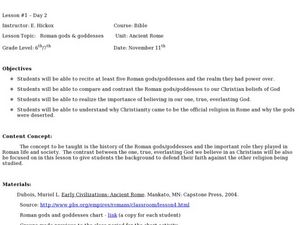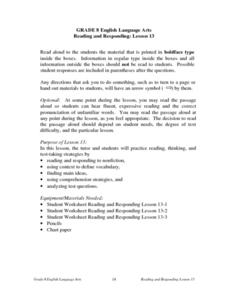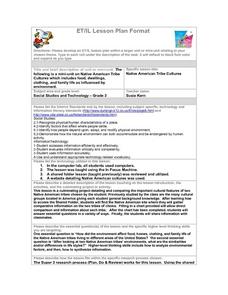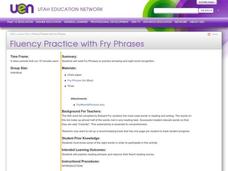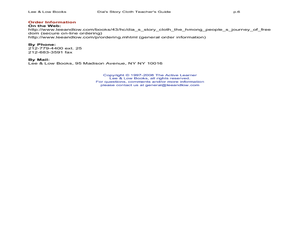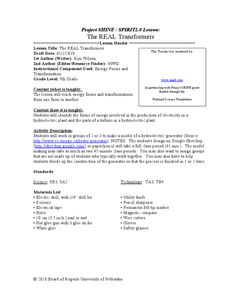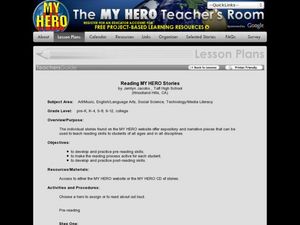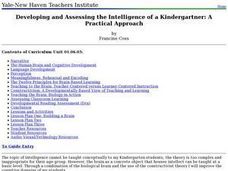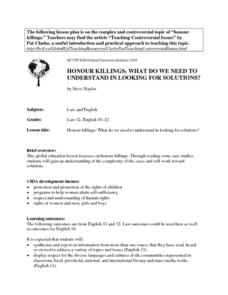Curated OER
Roman Gods and Goddesses
Students discuss Roman gods and goddess and give reasons the religion would be difficult to follow. In this Roman gods and goddesses lesson, students read the Legend of Romulus and Remus and complete a chart on all of the gods and...
Curated OER
Life in a Log
Young scholars identify insects living in rotting logs. In this decomposition lesson, students observe pieces of a rotting log, they look at the insects that have inhabited the log and create a chart that shows their findings.
Curated OER
Then and Now
First graders explore teacher created exploration tub, charts and cards to explain the concept of "Then and Now."
Curated OER
Dino Hunt
Students use the Internet to gather information about dinosaurs. They practice navagating through the different websites. They also practice listening to directions and also explore how to fill out a KWL chart.
Curated OER
Geo Jammin' - Day 1, Lesson 1: Gee Quiz!
Second graders are introduced to geometry by a teacher made puppet called Geo George.
Curated OER
Who's Who In America? Multicultural Achievers A to Z Past & Present
Students are introduced to important people who have made contributions to society from different cultural groups. As a class, they develop a definition for diversity and work together to make a comparison chart to discover how people...
Curated OER
Plains Indians
First graders create a KWL chart on Native Americans and listen to a speaker from a local Indian Reservation. As a class, they are read part of a Native American story in which they pick their own Native American name and identify their...
Curated OER
Reading and Responding -- Lesson 13
Fourth graders work independently or in a small group to (1) read a fictional passage, (2) use context to define unfamiliar vocabulary, (3) use comprehension strategies, and (4) make inferences. Reading passage and teacher script is...
Curated OER
Native American Tribe Cultures
Third graders choose two Native American tribes to compare and contrast using an assigned website. They complete a chart that shows how the tribes are the same and different. Using information gathered on their charts, they answer...
Curated OER
Identifying Instruments and Families
Fourth graders complete with the class a KWL chart and discuss prior knowledge of orchestras. They visit websites to discover instruments and families of the orchestra and discuss appropriate audience behavior prior to going to a concert...
Curated OER
Fluency Practice with Fry Phrases
First graders read Fry Phrases to practice phrasing and sight word recognition. The skills of reading a grade level text and fluency with accuracy are also practiced. The students pace themselves in reading with this type of practice.
Curated OER
The Uluburun Late Bronze Age Shipwreck
Students use the Internet to research Minoan and Mycenaean trade. In groups, they develop a chart showing the goods that were exported and imported. Using primary source documents, they examine the materials found in the wreckage of the...
Curated OER
Some Ways to Integrate Trade, the "Missing Link" into Ancient History
Ninth graders examine the importance of trade in the Mediterranean Sea. In groups, they create a chart of the items that were most popular in the late Bronze Age and where they originated. To end the lesson, they read an article out of...
Curated OER
Exchange of Goods and Ideas in the Ancient Mediterranean
Ninth graders begin the lesson by discussing and locating the trade routes in the Mediterranean. Using pieces of pottery and coins, they discuss how it shows the culture of an area and create a chart showing the value of the coins. ...
Curated OER
Mysterious Coin Discovery
Seventh graders examine mysterious coins. For this historical observations lesson, 7th graders use the provided chart to record information about the coins their instructor presents to them. Students discuss their work as archaeologists.
Curated OER
The Active Learner: "Dia's Story Cloth" Literature Guide
Learners discuss pre-reading focus questions and complete a KWL chart. In this language arts lesson, students mark passages or words they are unsure of with post-it notes to discuss later and answer comprehension questions after reading....
Curated OER
The REAL Transformers
Ninth graders create a model of a hydroelectric generator. In this physics lesson, 9th graders discuss how energy can be transformed from one form to another. They make a flow chart for different energy generating plants.
Curated OER
Reading My Hero Stories
Students use the My Hero website to help them develop their reading skills. They create a KWL chart for the hero of their choice.
Curated OER
Dichotomous Keys
Students classify objects and organisms using a dichotomous key. They are shown a demo by the teacher and then practice on their own. They discover why classification is important.
Curated OER
Developing and Assessing the Intelligence of a Kindergartner: A Practical Approach
Students name objects that are the same size, shape, and weight as the human brain. They touch the model brain, feeling the folds, etc. They make connections to the chart displaying the brain-like objects. They touch the 'potato flake'...
Curated OER
Masks from Around the World
Young scholars examine the history of masks, and create their own mask as a culminating activity. They view and discuss a PowerPoint presentation about the history of masks, complete a class KWL chart, create their own mask, and write a...
Curated OER
Tic-Tac-Toe, What Do You Know?
Young scholars review learned material with a game of tic-tac-toe. Students are divided into two groups, x's and o's. Teams are posed a review question and when answered correctly, they place their mark on a tic-tac-toe grid on the...
Curated OER
Honour killings: What do we need to understand in looking for solutions?
Students prepare a chart with four columns: things we know, things we think we know but need to check, things we wonder about, and new things we have learned. Each group is given a case study and they discuss the three cases of "honor...
Nazareth College
Create Your Own Tornado
Third graders identify key concepts and definitions about tornados. They work in small groups of three to four to create mini-tornados. After reading Tornado Alert as a class, 3rd graders discuss tornados and fill out a KWL chart.


